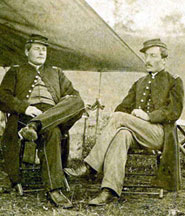|
Catherine Holden, Teacher, Franklin High School
- 7 - 9 (can be modified for high school and lower middle school students)
- 7 lessons plus extension activities
[Back to top]
|
- Gettysburg National Military Park, Gettysburg, PA
- Through object-based learning students will be able to explore how important it was to the Union to take Vicksburg, U.S. Grant’s attempts and methods to capture Vicksburg, how citizens were affected by the Siege of Vicksburg, and the effect Vicksburg had on the final outcome of the war.
Lesson One. Emotions of the Civil War Soldier: From Camp Boredom to Battle Chaos
Students analyze Civil War letters, diaries, songs, and historic photographs to identify with soldiers’ feelings during and after battle.
Lesson Two. “Dear Diary”: What Their Writings Reveal About Soldier Life
Students create their own journals to gain an understanding of the role of journals to the historian, assess soldiers’ journals, and then compare journal entries to more modern communication, such as e-mails and text messages.
Lesson Three. Beyond Words: Personal Values and Political Motives of Civil War Soldiers
Students examine soldiers’ belongings, written material and stationery to identify personal and political values. Students create a tombstone with an epitaph communicating those values.
Lesson Four. The Life of Officers versus the Life of Enlisted Men
Students analyze historic photographs and create packing lists to identify the material differences among military ranks, and then write a newspaper article on how those differences affect soldier life.
Lesson Five. Camp Life Innovations
Students further identify the material culture of soldiers and compare those materials with their needs in camp and on campaign. Students examine examples of adaptation, and create a Civil War recycling poster to apply their understanding of supply and demand.
Lesson Six. Escaping Boredom and Anxiety
Students explore soldiers’ leisure time activities, including games, and write an advice column for soldiers on how to avoid boredom and deal with stress.
Lesson Seven. Designing A Civil War Exhibit:
Students develop an exhibit on daily life in a Civil War camp to demonstrate their understanding of this unit.
- What was daily life like for Civil War soldiers?
How did Civil War soldiers combat boredom in camp and anxiety as battle approached?
How did Civil War soldiers cope with being away from home and family?
What can historians learn about their daily life from their writings, possessions, and photographs?
What were the political motives and personal values of Civil War soldiers, and how do we learn about them?
[Back to top]
|
| MUSEUM OBJECT [photos of objects in the Carl Sandburg Home NHS museum collections] |
SIMILAR OBJECTS [local items similar to museum objects] & OTHER MATERIALS |
Length of time |
Lesson One: Emotions of the Civil War Soldier: From Camp Boredom to Battle Chaos |
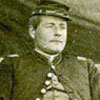 |
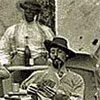 |
| Seated Soldier |
Playing Cards |
|
|
45-50 minutes
|
Lesson Two: Dear Diary”: What Their Writings Reveal About Soldier Life |
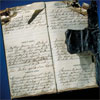 |
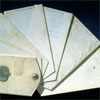 |
Rowe’s Diary |
Pocket Diary |
|
- Personal Diaries/Notebooks
- Other Civil War diaries
- Modern soldier diaries
|
90 minutes
|
Lesson Three: Beyond Words: Personal Values and Political Motives of Civil War Soldiers |
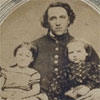 |
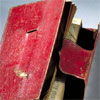 |
Carte de Visite “
John Shipman
and Daughters” |
Soldier’s Bible |
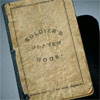 |
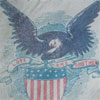 |
Prayer Book |
Patriotic Cover |
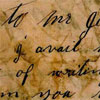 |
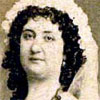 |
| Love Letter |
Carte de Visite “Unknown Bride” |
|
|
45-50 minutes
|
Lesson Four: The Life of Officers versus the Life of Enlisted Men |
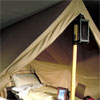 |
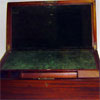 |
Officers Tent and Enlisted Men Tent |
Portable Writing Desk |
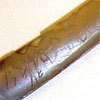 |
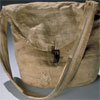 |
Straight Edge Razor |
Haversack |
|
[similar to objects in the Park museum collection]
- practice jersey
- tennis shoe
- sponge football
- suitcase
- lamp
- coffee pot
- heavy blanket
- book
- candle
- cup
- bed sheet
- playing cards
|
45-50 minutes
|
Lesson Five: Camp Life Innovations |
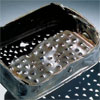 |
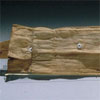 |
Corn Grater from a Sardine Can |
Money Belt from a Shirt Sleeve |
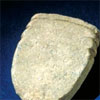 |
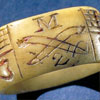 |
Poker Chips from Bullets |
Ring |
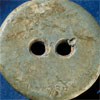 |
|
| Button |
|
|
[similar to objects in the Park museum collection]
- tin container
- long sleeve shirt sleeve
- metal marble
- fake rubber bone
- block paper
- markers
|
45-50 minutes
|
| Lesson Six: Escaping Boredom and Anxiety |
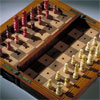 |
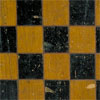 |
| Pocket Chess Set |
Checkerboard |
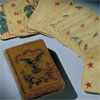 |
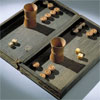 |
Playing Cards
|
Backgammon Set |
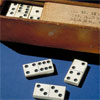 |
 |
| Domino Set |
Playing Cards |
|
[similar to objects in the Park museum collection]
- board games
- playing cards
- checkerboard
- chess set
- backgammon
- dominos
|
45-50 minutes
|
Lesson Seven: Designing A Civil War Exhibit |
[similar to objects in the Park museum collection]
- textbook
- pencil
- student ID
- pencils
- paper
- paper box/shoebox
|
90 minutes
|
[Back to top]
|
Understands the course and character of the Civil War and its effects on the American people.
Students read a wide range of literature from many periods in many genres to build an understanding of the many dimensions (e.g., philosophical, ethical, aesthetic) of human experience.
Students apply a wide range of strategies to comprehend, interpret, evaluate, and appreciate texts. They draw on their prior experience, their interactions with other readers and writers, their knowledge of word meaning and of other texts, their word identification strategies, and their understanding of textual features (e.g., sound-letter correspondence, sentence structure, context, graphics).
Students adjust their use of spoken, written, and visual language (e.g., conventions, style, vocabulary) to communicate effectively with a variety of audiences and for different purposes.
Students employ a wide range of strategies as they write and use different writing process elements appropriately to communicate with different audiences for a variety of purposes.
Students use a variety of technological and information resources (e.g., libraries, databases, computer networks, video) to gather and synthesize information and to create and communicate knowledge.
Students use spoken, written, and visual language to accomplish their own purposes (e.g., for learning, enjoyment, persuasion, and the exchange of information).
Students reflect on how artworks differ visually, spatially, temporally, and functionally, and describe how these are related to history and culture.
Students differentiate among a variety of historical and cultural contexts in terms of characteristics and purposes of works of art.
[Back to top]
|
- Students will be able to identify the daily experiences and emotions of Civil War soldiers.
- Students will be able to compare and contrast the material culture of officers and enlisted men in the Civil War.
- Students will be able to think critically about the writings, possessions, and photographs of Civil War soldiers and their lives in camp, and what these items say about the values and beliefs of individuals, community, and society.
[Back to top] |
Causes of the Civil War
The general consensus of historians today is that the slavery issue led to secession and secession led to Civil War. While there were differences between the North and South and their views of government, the South was not averse to using the power of the Federal government when it served to protect slavery, such as the Fugitive Slave Act of 1850. Secession declarations clearly note why states felt secession was necessary, stating that succession would protect their right to own slaves. Abraham Lincoln’s election on a Republican platform that declared that it would block the extension of slavery into the territories prompted secession. This meant that there were no new markets for slaves. That, in turn would drive down the value in slaves and place the future of slavery, and hence the massive investment in the institution, in jeopardy.
Battle of Gettysburg July 1 - 3, 1863
General Robert E. Lee led his Army of Northern Virginia into Pennsylvania in June of 1863. Lee's invasion was intended to do the following:
- inflict a military defeat on the Army of the Potomac that would damage, perhaps critically, Northern morale and support for the war
- upset the plans of the Union armies for the summer of 1863
- gather supplies from Pennsylvania
- capture Harrisburg, Pennsylvania's state capital- an event that would both embarrass the Lincoln administration and damage northern morale.
The battle on July 1 began when Confederate infantry advanced on Gettysburg and encountered Union cavalry who had delayed their advance until Union infantry arrived. From this point, the battle escalated until the full strength of both armies was committed. After his defeat, Lee withdrew his army behind the Potomac River to Virginia. The Union victory at Gettysburg increased northern morale. It gave new hope that the Confederacy could be defeated and the nation reunited. President Lincoln’s Gettysburg Address, a speech to dedicate the Soldiers’ National Cemetery in Gettysburg, poetically solidified the now dual mission of the war – to keep the country united and to end slavery.
Life in Camp
The Civil War is known for its many battles and military engagements, however, the Civil War soldier’s daily experiences rarely centered on combat. Drill and camp duties, fatigue during campaign marches, and a host of emotions – from boredom to homesickness to anxiety – comprised most of their days. While in camp, two soldiers usually shared a tent and their personal belongings. The soldier’s military possessions were stored in the tent. Soldiers were responsible for maintaining their wool uniforms, muskets, and a cartridge box with ammunition. The tent housed the soldier’s personal effects and items needed for daily life. The soldier carried tin cups, eating utensils, and plates for the daily food rations issued by the quartermaster. The food in camp consisted of hardtack, dried meats, beans, salt pork and coffee. Soldiers kept personal items such as diaries, letters from home, and pictures of loved ones in their tents, or wrapped within their bedrolls on the march.
Life in camp required soldiers to drill, stand watch, and perform regular military duties. When not performing military duties, soldiers came up with simple and creative ways to entertain themselves. From playing cards to checkers, Civil War soldiers played basic games with each other in order to pass the time. They also used their time to adapt objects found on the battlefield like wood and bones into objects they wanted and needed like forks, dice, and buttons. While the soldiers played their games and mended their clothes, music was a welcome pastime in an otherwise dull camp life.
Photography
The Civil War represents the first photographically documented war in American history. The technology of photography was not yet highly developed at this time. Photographers needed their subjects to sit still or without movement for several minutes. While early photography had its limitations, it captured remarkable images of devastation and death on the battlefield as well as images of soldiers relaxing and entertaining themselves in camp. It allows historians and students to gain an immediate and tangible understanding of the daily life of Civil War soldiers.
[Back to top] |
Cavalry – Soldiers who travelled on horseback, scouting the enemy and screening their own army. They also fought in engagements with other cavalry or dismounted against infantry as well.
Enlisted man – A member of the military whose rank is below a commissioned officer.
Goober Peas – Refers to peanuts, a staple of Southern agriculture. It is also the title of a folk song from the American Civil War popular in the South,
Haversack – The cloth pack soldiers used to carry their belongings and food rations. It was often tarred to withstand weather and carried over one shoulder.
Campaign – A series of battles. In between the battles, soldiers marched all day in the hot sun along dusty roads, or in the rain along muddy roads, carrying their heavy equipment.
Infantry – The main fighting branch of a Civil War army. Often called foot soldiers, the infantry traveled on foot and fought with a musket-rifle.
Officer – A member of the military whose rank allows him to command enlisted men.
[Back to top]
|
|
- Download color images of museum objects with complete captions from the virtual exhibit for reference and use.
- Display color images of museum objects for class discussion using available technology.
- Teachers must follow school district guidelines on food in the classroom.
- Check resource section and URLs for primary source material ahead of time.
[Back to top] |
- Students will be able to compare and contrast life in camp versus life on campaign for the Civil War soldier.
- Students will able to identify the feelings associated with battle and waiting around in camp during the Civil War.
- Students will be analyze Civil War music and determine which emotions are elicited.
The class will examine two Civil War images and two written excerpts that provide contrasting views of the Civil War: the boredom of camp and the chaos of battle. For the chaos of battle, two photographs were taken following battles. The written source is a letter to Eleanor Stuart Brooks from Charles Brooks discussing the destruction he witnessed during the Seven Days’ Campaign in June, 1862. For the boredom of camp life, the photographs show officers and soldiers sitting around and playing cards. The written source is an 1862 diary from Thomas M. Smiley that describes the life in camp.
- Provide each student with a slip of paper identifying one of five emotions: boredom, excitement, loneliness, homesickness, or anxiety. Each student will then write a scenario of 2 - 3 sentences that demonstrates that emotion.
- Students move into groups based on their emotional terms, and develop a list of events/scenarios that elicit their emotion. Each group presents their scenario lists to the class.
- The teacher concludes the activity by asking:
- How do events create emotional responses?
- Would you rather be bored or anxious? Explain.
- How do you think this activity relates to times of war?
Students complete questions in Handout #1 “The Emotions of the Civil War” with historic photos and diary excerpts, identifying the emotional responses elicited. Students share their responses with a partner and discuss the following:
- How did Civil War events create emotional responses?
- If you were a Civil War soldier, would you rather be bored or anxious? Explain.
- How did loneliness add to the anxiety of their situation?
- Besides battle, what other activities made up a soldier’s life?
The class examines lyrics of the song titled Goober Peas as these lyrics present the dual nature of the Civil War. Specifically, students should be instructed to identify and underline terms and phrases that exemplify the chaos of battle and monotony of camp. (See resource section for Civil War music.)
The class completes a t-chart (see below) together that identifies lines within the song that support these two emotions of soldier life. Then, the students’ debate whether the song is more about camp life or the battlefield and determines which image best illustrates the emotional response of this Civil War song.
Lyrics Supporting Battle Experience/Emotion |
Lyrics Supporting Camp Life Experience/Emotion |
|
|
- Students will be able to write diary entries about their daily experiences.
- Students will be able to analyze daily life during the Civil War by analyzing soldiers’ diaries.
- Students will be able to think critically about the role of diaries and primary source material for historians.
Students focus on the blood-stained diary of Alfred S. Rowe (GETT 7304) and H.D. Planck’s pocket diary [H.D. Planck’s pocket diaryGETT 43968 (1863) and GETT 43969 (1864)]. Alfred S. Rowe served in Company C of the 6th Maryland Infantry, and H.D. Planck served in Company H of the 18th Michigan Infantry.
1. A week prior to this lesson, have students write several lines each day for 7 days, recording their daily lives. At unit start, brief students on how diaries help historians understand people and events of the past. Based on their seven-day diaries, students individually analyze diaries and note the following:
- What topic is most frequently addressed in your diary?
- Because of the limitation on length, what information did not get included?
- What similarities or differences do you expect within the diaries of the whole class?
2. Together, the class answers the following questions:
- What was generally not included in these diaries?
- What seems most important to this class? What did you collectively mention the most?
- What are the trends as a class, and perhaps then for your age group?
- How do the diaries generally differ?
3. Students will later compare and contrast Civil War diaries with their own to explore parallels as well as examine the role of diaries in helping us to understand multiple perspectives for one event and time period.
1. Students move into small groups. Supply each group with a color copy of the Alfred S. Rowe and H.D. Planck diaries. Students complete the chart below individually, before and after their diary readings, and then together they discuss the similarities and differences between the two diaries.
2. Disseminate Handout #2 “The Day to Day Existence of a Civil War Soldier” and “Resource #1: Diary Transcript”. Complete individually or as a class.
The Day-to-Day Existence of a Civil War Soldier: Alfred S. Rowe and H.D. Planck Diaries |
What do you think
you are going to read about? |
|
What did you read about? |
|
What do you still want to know? |
|
3. After the students assess the soldier diaries (10-12 minutes), lead a class discussion as follows:
- What were your expectations for the diary’s contents, and were they met?
- What did the diary discuss repeatedly?
- What was a typical day like for the soldier?
- What did the soldier seem to value?
- What did the diary actually tell you about Civil War soldiers that was surprising?
- What did the diary not address? Why do you think certain topics were not discussed?
- What do you still want to know about? What is still unknown?
After examining an historic diary in small groups, each student will now receive his/her own excerpt from a Civil War diary. Obtain and photocopy excerpts from various Civil War diaries (see Section L, Resources). Each student completes a chart like the one below, before and after they read their individual excerpts.
Day to Day Existence: My Assigned Civil War Diary |
What do you think
you are going to read about? |
|
What did you read about? |
|
What do you still want to know? |
|
Then, students assess their historic diary entry, filling in the first column of a chart like the one below (rows can be, of course, added as needed):
Main Ideas and Actions
of My Civil War Diary |
Other Civil War Diaries With Similar Information
(State Student and Soldier’s Name) |
1. |
|
2. |
|
To complete the second column, students seek other students with soldier excerpts that have similar content. At the conclusion of the activity, lead a discussion with the class to answer the following questions:
- What information was provided in more than one diary?
- Was there any information stated in more than five diaries?
- What information was only stated in one diary?
- What do you still want to know about?
Students will be able to analyze icons, symbols, and images that motivated Civil War soldiers.
Students will be able to communicate, via an epitaph, the political and personal values of at least one soldier.
The class will review letters written by Jacob L. Bechtel, 59th New York Volunteers during the Civil War. For this lesson, students will focus on stationary iconography rather than on the text of the letters, utilizing Handout #3. Students will also examine soldiers’ possessions, including a bible (GETT 9018) and prayer book (GETT 42096) to understand the importance of religion and family. Students then examine photographs of loved ones, including an unknown bride (GETT 42453), and John Shipman and his daughters (GETT 28271).
1. Teacher passes around various state quarters and asks the class to identify symbols and words on the quarters. Limit the selection to a few states, but include the state where the school is located, if possible. View quarters on screen with the class and discuss their symbols, text and meaning. Ask students to surmise why these things were selected to represent that state.
Sample
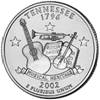
|
Tennessee Quarter
As Nashville, TN is the home of country music, the state opted to honor their musical heritage and feature musical instruments on their state quarter, including a horn, fiddle and guitar, as well as music sheets. |
2. Then, each student should design both sides of a quarter about themselves using 5-inch round heavy stock paper. The ‘coin’ should include their name and three important images/icons that represent his/her values or beliefs. Each student should explain their design and its symbolism to the class.
1. Each student completes the front of Handout #3 (“Political Motives and Personal Values”), identifying symbols on stationery used by Jacob L. Bechtel, a soldier in the Civil War. Together the class speculates on how they reflect his political values by discussing the following:
- What images are located on the stationery?
- Why might those images and icons be important to a soldier fighting for the Union?
- What images or icons would we expect to see on a soldier fighting for the Confederacy?
- How would they differ? What similarities might exist?
2. Students examine images of the personal photographs and other belongings of soldiers and complete the back of Handout #3 (“Political Motives and Personal Values”) individually. Students then speculate on the significances of these items to the values and beliefs of their owners, by discussing the following:
- What personal items did the Civil War soldier possess?
- Why might those items be important to the soldiers?
- What similarities might exist between a Union and Confederate soldier’s belongings?
3. The class constructs a master list of the political and personal values of Civil War soldiers using their answers to the questions above,
1. Students view actual tombstones of Civil War soldiers, and then discuss the following:
- What images are visible on the stone?
- What words are used?
- What is the general feeling and message of the tombstone?
2. Students then design a Civil War soldier’s tombstone on sketch paper (or graphically on a computer) that includes at least two icons and a short epitaph. They should select a soldier whose history, values and beliefs are evident.
Students will be able to compare and contrast the day-to-day life of enlisted men and officers.
Students will be able to analyze photographs to identify the differences in camp life between the military ranks.
Students examine two photographs of staged exhibits that illustrate life in camp for enlisted men and officers. In the officer’s tent, objects such as a carpetbag, chest, cot, and wool blankets are visible (GETT 6068). In the enlisted men’s tent, the more humble equivalent can be seen. Students will work with the following images:
- Portable writing desk (GETT 6832) – This desk belong to Lieutenant John L Wright, Union Army officer.
- Straight edge razor (GETT 9126). Owner unknown.
- Sword belt plate (GETT 10592) –Belonged to a Union Army officer.
- Haversack (GETT 143) –Used to carry rations and supplies; this one has been mended showing its importance.
Display soft football, tennis shoes, and a penny jersey. Students identify each item and its function for elementary football players. Then, discuss how these items differ from the equipment for professional football players.
1. Divide the class into two groups: one gets a printout of the enlisted men’s tent, and the other gets the printout of the officer’s tent. Each group creates a packing list for the articles in their tent.
2. Then students find a partner from the other group, share their photograph and packing list to complete a Venn diagram comparing the two types of soldiers (see Handout 3, “Venn Diagram”).
3. Students analyze the images of the portable writing desk, straight edge razor, sword belt plate, and haversack, using a “How to Read an Object” chart for each. Partners determine if the items belong in the packing list for officers, enlisted men, or both and explain their rationale.
4. After examining the tents and completing these exercises, discuss the following with the class:
- What were similarities between Civil War officers and enlisted men?
- Based on the objects within their tents, how were their lives different?
- How do their belongings reflect their rank and life in camp?
Students select and analyze an historic Civil War photograph using the “How to Read a Photograph” chart, and then determine whether it illustrates the lifestyle of an officer or of an enlisted man. Students then add a title to the photograph and label three objects that support their designation as well as a one-sentence rationale for each item circled.
Students will be able to identify innovations created by Civil War soldiers in camp.
Students will be able to create supply and demand charts that demonstrate soldier’s needs in the Civil War, in contrast to their demand for certain types of items.
Students will be able to create an alternative use for an item of their choosing.
Civil War objects used in this lesson demonstrate how innovative soldiers were during the Civil War, and include:
- corn grater made from a sardine can (GETT 27218);
- money belt made from a shirt sleeve (GETT 9089);
- poker chips made from bullets (27873A-C);
- ring (GETT 5239) with engraved icons;
- button made from a bullet (GETT 28099).
1. Students form into small groups, and each group receives a box containing four objects: small tin container, such as for mints; a shirt sleeve; a marble; and a fake rubber bone. The objects are labeled A, B, C, and D.
2. Groups identify the items and brainstorm possible alternative functions, completing the column labeled “Alternate Functions of the Modern Example” in a chart similar to the one below. Each group will be given 5 minutes to work together to brainstorm ideas.
|
Alternate Function of the Modern Example |
Civil War Equivalent |
Alternate Function of the Civil War Example |
Reason Needed |
A |
|
|
|
|
B |
|
|
|
|
C |
|
|
|
|
D |
|
|
|
|
1. Teacher now relates the modern objects in Activity #1 with the Civil War equivalent. Starting with Object A, the tin box, the teacher asks students to guess possible alternate functions for Civil War soldiers. Class views image of the sardine can with the holes punched in it and completes the remaining columns on the chart.
Example:
|
Alternate
Function |
Civil War
Equivalent |
Alternate Function |
Reason Needed |
A |
- to hold pins
- wallet
- coin purse |
Sardine Can |
Corn Grater |
Soldiers removed corn on the cob more speedily and effectively. |
B |
- belt
- hair tie
- bandage |
Shirt Sleeve |
Money Belt |
Shirt sleeve allowed the soldier to safely carry his valuables at all times. |
C |
- game
- coin/currency
- bullet |
Bullet |
Buttons and Poker Chips |
Used bullets were crafted into buttons or used as chips to play card games. |
D |
- back scratcher
- cross |
Bone |
Ring |
Allowed soldiers to be creative with battlefield tokens/souvenirs. |
2. Following the completion of the chart, the class will be asked the following questions:
- Why did soldiers develop these alternative tools?
- What do these items tell us about the daily life of soldiers in camp?
Each student constructs a recycling poster for a Civil War object. Students select one of the items listed above and create a slogan and visuals that encourages recycling objects into alternative functions.
Students will be able to identify various methods used by Civil War soldiers to combat boredom while in camp.
Students will be able to debate the significance of leisure activities in combating boredom and other wartime emotions.
Students examine leisure time objects, including those for sketching, playing music, and games such as checkers, chess, backgammon, dominos, and cards.
1. Ask the students: If the power went out, what would you do for fun? What games would you play? What games or activities could you not play?
2. Together, the class brainstorms a list of non-electronic games and activities.
3. Teacher underlines (or adds to) the list the following games: dominos, checkers, backgammon, and cards. If the students do not recognize one of the games/objects the teacher should briefly explain it.
1. Provide students with images of the following museum objects: domino set, checkerboard, cards, chess set, and backgammon.
2. Ask the class:
- How do these activities compare to our modern-day activities and games? What is alike and what is different about them?
- What other modern non-electronic game could have been liked and carried by the Civil War soldier?
3. Provide each student with a copy of “Officers of the 114th Infantry Playing Cards” historic photograph. Each student should be instructed to write a three-minute, three-act play that addresses what occurred before, during, and after the picture in dialogue format. Characters include enlisted men and officers with different perspectives on entertainment. Specifically, the play should answer the following:
- Before: What were the soldiers doing before this picture? How did they feel?
- During: What are they now doing? What might they be saying? How do they feel?
- After: How might they reflect on the activity? How do they feel? What will they do next?
Each student is instructed to write a response to the letter below. Their response should be no less than 7-9 sentences and must include recommended past time activities and games, referencing new items created from objects already in camp.
To Whom It May Concern
I have been in camp for many months. I feel as if I am losing my mind and I have no way of escaping the boredom and terror of waiting. While waiting for the next battle, what should I do to distract and console myself?
-- Bored and Anxious in a Civil War Camp
Students will be able to demonstrate their knowledge of Civil War camp life by developing a museum exhibit.
Students will be able to use primary sources to support the quote: “Soldiering is 99% boredom and 1% sheer terror.”
Teacher displays a textbook, a pencil, and a student identification card. Ask students if these items define any type of person. Then ask the students to select three different items that better define their role as student. Introduce the following questions for discussion:
- Are you more than just students? What else defines you as a person?
- What three objects best define you as a student? As a teenager? As an American student/teenager?
1. Students will be tasked with developing an exhibit that focuses on the concept written by a Civil War soldier to his wife: “Soldering is 99% boredom and 1% sheer terror.” Briefly discuss the quote to ensure that all students understand the complexity of soldier life.
2. Now, organize class into small groups of 3-4 students each. Each group will be responsible for creating a museum exhibit using the objects and sources that have been used throughout this unit plan (See Section L Resources).
3. Instruct the student groups to develop a museum exhibit proposal that includes:
Title: Create a catchy museum exhibit title;
Theme: Describe briefly the overall statement that you want your exhibit to make;
Objects: Select six objects and explain how each object supports the exhibit’s theme.
Historic Documents: Select three quotes from diaries or letters and explain how each printed source supports the exhibit’s theme.
- Groups identify appropriate historic photos and illustrations for inclusion into the exhibit.
- Each group develops the exhibit theme text and captions for object, historic photos, and illustrations.
- Groups develop
- radio or print advertisements promoting the new exhibit
- related items with accompanying tags designed to be sold in the museum store.
- video clip of a Civil War soldier talking answering questions about his experiences
- Students prepare a docent/guide narrative text for the exhibit and lead class mates on a tour of the exhibit.
|
- See individual lessons.
- For a cumulative assessment, see Lesson #7.
[Back to top]
|
|
1. A Modern Civil War Soundtrack: Each student creates a modern sound track for the Civil War by selecting six modern songs that embody Civil War emotions. Students identify the title and artist and briefly state why the songs embody emotional aspects of the Civil War.
2. More Civil War Music: Using a Civil War Music website, each student will select another set of Civil War lyrics and explain to what extent they demonstrate the emotions elicited by either battle or camp life.
3. Defend or Refute: The students should defend or refute this concept, written by a Civil War soldier to his wife: “Soldiering is 99% boredom and 1% sheer terror”. For this exercise, they will write 5-6 sentences that reference the images and sources used in this lesson in support of the argument.
1. Historic Tweets: After examining the various Civil War diaries, each student writes five notes in the persona of a Civil War soldier about soldiering, no longer than 15 words, in a contemporary format such as an e-mail or blog. The class should compare and contrast the period communications with modern communications.
2. A Modern Soldier’s Diary: Provide students with excerpts from writings, including blogs, of current American soldiers fighting in Iraq and Afghanistan. The students create a script of an interview of a contemporary and civil war soldier that demonstrates the similarities and differences between the two. See Resource Section L for U.S. soldier blogs. Students discuss the following questions regarding information on the Internet:
- How does language used on an Internet blog differ from a personal diary?
- How may the content of an Internet blog be different from a personal diary?
- What is the difference between private and public information?
- What might not be included on Internet blogs?
- What should or should not be included on internet blogs? Why or why not?
- Newspaper Article: Using information gathered by reading about modern soldiers and soldiers throughout history, each student and writes a newspaper or magazine article that compares and contrasts the soldier’s experience today with the experience of a 19th century soldier. The article has a minimum of three body paragraphs that address the similarities and differences, with sources referenced.
- Movie Review: The students view a civil war film (such as Glory) and grade it on its ability to accurately portray life in camp and life on the battlefield by writing a movie review.
1. Personalized Tombstone: Using the Civil War Soldiers and Sailors database (see link in Resource Section L), students work to identify an actual Civil War soldier, his dates of birth and death, the battles in which he fought, family information, and any other data that they feel should be included on the personalized tombstone that they will draw/create in his honor.
2. Patriotic Stationery: Students create his/her own patriotic envelope and stamp for the Bechtel letters (GETT 40367, 40372, 40375).
3. Letters Home: Each student will write a letter to a family member or friend that describes camp life during the Civil War. This letter must be at least 10 sentences long and describe motives for fighting, observations of fellow soldiers, and feelings about home.
1. Write an Expose’: Students write an article about the differences between the Civil War enlisted men and officers that speculates on the function of rank, with specific reference to life in camp for enlisted men and officer and why a command structure is necessary in the military.
2. Civil War Skits: Organize class into groups of five. Provide each group with contemporary objects similar to Civil War period objects found in the tents – either enlisted men’s tent or officer’s tent. Examples for officers include: suitcase, lamp, coffeepot, heavy blanket, and book. Examples for enlisted men include: book bag, candle, cup, thin sheet, deck of cards. Groups determine if the objects belonged to an enlisted man or an officer and write and perform a two-minute skit using the objects to explain what daily life would have been like for that rank of Civil War soldier.
- A Civil War Lunch: Students create a Civil War soldier’s meal by using the recipes and dietary descriptions below. The students only pack items considered “Civil War Foods” in their lunch and the teacher supplies the class with hardtack.
Civil War Foods |
Hardtack Recipe |
Hardtack, salt pork, vegetables, jam, eggs, cornbread, water, bread, nuts, honey, dried beef, coffee, butter, oatmeal cookies, apples. |
Ingredients: 2 cups of flour, 1 cup of water, 6 pinches of salt
Directions: Mix well and spread dough ½ inch thick onto baking sheet. Bake for ½ hour at 400 degrees. Remove from oven, and cut dough into 3 inch squares. Turn dough over, return to oven and bake for another ½ hour. Turn oven off, leaving oven door closed, and allow hardtack to cool. |
Students sample the hardtack and answer the following:
● How does this food taste?
● What modern food does it remind you of?
● Since this food is made up of flour, water, and a pinch salt, do you think it is healthy for you?
● Why would this food item be widely used during the Civil War?
After lunch, students answer the following questions:
● What foods did you use in your lunch?
● What utensils did you use to prepare, and then eat the food?
● How did your food taste on a scale from 0 (very bad) to 10 (very good)?
● What food do you wish you could have included in your lunch?
● Would you want to eat these foods every day?
● Which soldier(officers or enlisted men) do you think ate these foods? What do you think the other ranks ate and drank?
● How does this compare with your lunch, and which is healthier?
Note: Meals in camp and meals on campaign were different. On campaign there would be a scarcity of fresh fruits and vegetables and meats. Discuss why the meats were salted and vegetables desiccated. Also consider allowing students to research army food rations and distribution systems during the civil war by using library resources.
1. Directions: Student select an innovated item from the lesson, and write detailed directions on how to create this object, and then how to use it in camp.
2. Write and Perform a Commercial: Divide class into five groups and assign each group one of the five innovated items from the Gettysburg collection. Each group should create a 30-second commercial that identifies the object and its function. Students then write and perform the commercial skit.
3. Innovate and Create a Marketing Strategy: Select and modify an object from the Gettysburg National Military Park virtual exhibit. Then, create a marketing portfolio that addresses the following: its original function; its new function; explanation of why the new function would be useful to a Civil War soldier; step-by-step directions on how to create this object; a billboard advertising this new object.
1. Design a Postal Stamp: Teacher describes the following scenario: The U.S. Postal Service has decided to issue commemorative stamps honoring leisure time activities in combating boredom and stress during the Civil War. Create three stamps that commemorate these activities and write a paragraph explaining how they helped soldiers to cope.
2. Interview a Veteran: Students are instructed to interview a veteran about his/her experiences in the military during “downtime”. Questions to ask might include::
- When did you serve in the military? (i.e. years)
- When not working, what did you do for fun?
- What games did you play?
- How often were you and your military friends bored?
- Did you have any creative solutions to your boredom?
- How did you cope with your other emotions – fear, anxiety, homesickness?
Students write a two paragraph analysis of the interview. The first paragraph will be a summary of how contemporary soldiers entertain themselves during down time in camp. The second paragraph compares the Civil War soldiers with contemporary soldiers. Students discuss their interviews and the American modern military as it relates to leisure time.
3. Time Travel Journal: Students will be asked to create a series of journal writings from the perspective of a soldier in the middle of the Civil War. Students can determine their own perspectives, addressing the following questions within the context of their writings:
● Are you an enlisted man or officer, or other such as a doctor, nurse, mother, wife or sister?
● What is your gender?
● How old are you?
● Are you fighting for the Union or the Confederacy?
● Are you from a city or from the country?
● What do you do for fun in the army?
● What do you miss about home?
● What have you witnessed as a soldier?
● What belongings do you most value? Why?
● Describe your experiences in the camp.
● How do you maintain relationships with people and loved ones at home?
1. Research Project: Students compare and contrast the experiences of the Civil War soldier to an American soldier from a different time period. Examples to choose from include: French and Indian War, American Revolution, World War I, World War II, Korean War, Vietnam War, or Desert Storm. Students will need to research the time period, equipment, pastimes, and emotions to ascertain the similarities and differences of the soldier’s experience.
2. Scrapbooking: Divide students into groups of 3 or 4, and task them with creating a Civil War era scrapbook with 12 historic images. Each image should have a title and a brief narrative caption about it, such as an image of Fort Sumter labeled “The War Begins,” and the narrative caption reads “The Civil War began here in April of 1861, and I joined the Union Army later that month.”
3. Traveling Trunk: Students can create their own Civil War trunk or borrow a trunk filled with modern copies of accouterments (including a Pastimes station) from the Gettysburg National Military Park traveling trunk program.
|
Civil War Music:
Civil War Diaries:
American Soldier Blogs
Civil War Sketches & Photographs
Other Recommended Websites
Vicksburg National Military Park: http://www.nps.gov/vick
U.S. Mint: http://www.usmint.gov/mint_Programs/50sq_program/?action=designs_50sq
Arlington House - A Robert E. Lee Memorial: http://www.nps.gov/arho
Bibliography
Bonner, Robert E. The Soldier's Pen: Firsthand Impressions of the Civil War. New York: Hill and Wang, 2006.
Foner, Eric. Reconstruction: America's Unfinished Revolution, 1863-1877. New York: Harper & Row. 1988.
Manning, Chandra. What This Cruel War Was Over: Soldiers, Slavery, and the Civil War. New York: Alfred A. Knopf, 2007.
McPherson, James M. For Cause and Comrades: Why Men Fought in the Civil War. New York: Oxford University Press, 1997.
Mitchell, Reid. Civil War Soldiers. New York, N.Y., U.S.A.: Viking, 1988.
McPherson, James. Battle Cry of Freedom: The Civil War Era. Oxford History of the United States. 1988
Sheehan-Dean, Aaron Charles. The View from the Ground: Experiences of Civil War Soldiers. Lexington, KY: University Press of Kentucky, 2007.
Wilson, Keith P. Campfires of Freedom: The Camp Life of Black Soldiers During the Civil War. Kent [Ohio]: Kent State University Press, 2002
[Back to top]
|
A visit to Gettysburg National Military Park or civil war historic site, society or monument is recommended.
[Back to top] |
|

